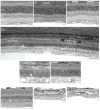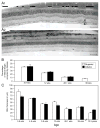Age-dependent disease expression determines remodeling of the retinal mosaic in carriers of RPGR exon ORF15 mutations
- PMID: 19255154
- PMCID: PMC2718058
- DOI: 10.1167/iovs.08-3364
Age-dependent disease expression determines remodeling of the retinal mosaic in carriers of RPGR exon ORF15 mutations
Abstract
Purpose: To characterize the retinal histopathology in carriers of X-linked progressive retinal atrophy (XLPRA1 and XLPRA2), two canine models of X-linked retinitis pigmentosa caused, respectively, by a stop and a frameshift mutation in RPGRORF15.
Methods: Retinas of XLPRA2 and XLPRA1 carriers of different ages were processed for morphologic evaluation, TUNEL assay, and immunohistochemistry. Cell-specific markers were used to examine retinal remodeling events.
Results: A mosaic pattern composed of patches of diseased and normal retina was first detected in XLPRA2 carriers at 4.9 weeks of age. A peak of photoreceptor cell death led to focal rod loss; however, in these patches an increased density of cones was found to persist over time. Patches of disease gradually disappeared so that by 39 weeks of age the overall retinal morphology, albeit thinner, had improved lamination. In older XLPRA2 carriers (>or=8.8 years), extended regions of severe degeneration occurred in the peripheral/mid-peripheral retina. In XLPRA1 carriers, opsin mislocalization and rare events of rod death were detected by TUNEL assay at 20 weeks of age; however, only patchy degeneration was seen by 1.4 years and was still apparent at 7.8 years.
Conclusions: The time of onset and the progression of the disease differed between the two models. In the early-onset form (XLPRA2) the morphologic appearance of the retinal mosaic changed as a function of age, suggesting that structural plasticity persists in the early postnatal canine retina as mutant photoreceptors die. In the late-onset form (XLPRA1), patches of disease persisted until later ages.
Figures









Similar articles
-
A frameshift mutation in RPGR exon ORF15 causes photoreceptor degeneration and inner retina remodeling in a model of X-linked retinitis pigmentosa.Invest Ophthalmol Vis Sci. 2006 Apr;47(4):1669-81. doi: 10.1167/iovs.05-0845. Invest Ophthalmol Vis Sci. 2006. PMID: 16565408
-
Molecular studies of phenotype variation in canine RPGR-XLPRA1.Mol Vis. 2016 Apr 9;22:319-31. eCollection 2016. Mol Vis. 2016. PMID: 27122963 Free PMC article.
-
Different RPGR exon ORF15 mutations in Canids provide insights into photoreceptor cell degeneration.Hum Mol Genet. 2002 May 1;11(9):993-1003. doi: 10.1093/hmg/11.9.993. Hum Mol Genet. 2002. PMID: 11978759
-
Natural models for retinitis pigmentosa: progressive retinal atrophy in dog breeds.Hum Genet. 2019 May;138(5):441-453. doi: 10.1007/s00439-019-01999-6. Epub 2019 Mar 23. Hum Genet. 2019. PMID: 30904946 Review.
-
A review of research to elucidate the causes of the generalized progressive retinal atrophies.Vet J. 1998 Jan;155(1):5-18. doi: 10.1016/s1090-0233(98)80028-2. Vet J. 1998. PMID: 9455155 Review.
Cited by
-
Rod Outer Segment Development Influences AAV-Mediated Photoreceptor Transduction After Subretinal Injection.Hum Gene Ther. 2017 Jun;28(6):464-481. doi: 10.1089/hum.2017.020. Hum Gene Ther. 2017. PMID: 28510482 Free PMC article.
-
CELLULAR IMAGING OF THE TAPETAL-LIKE REFLEX IN CARRIERS OF RPGR-ASSOCIATED RETINOPATHY.Retina. 2019 Mar;39(3):570-580. doi: 10.1097/IAE.0000000000001965. Retina. 2019. PMID: 29190250 Free PMC article.
-
Optimization of Retinal Gene Therapy for X-Linked Retinitis Pigmentosa Due to RPGR Mutations.Mol Ther. 2017 Aug 2;25(8):1866-1880. doi: 10.1016/j.ymthe.2017.05.004. Epub 2017 May 27. Mol Ther. 2017. PMID: 28566226 Free PMC article.
-
Candidate Genetic Modifiers for RPGR Retinal Degeneration.Invest Ophthalmol Vis Sci. 2020 Dec 1;61(14):20. doi: 10.1167/iovs.61.14.20. Invest Ophthalmol Vis Sci. 2020. PMID: 33326016 Free PMC article.
-
Gene augmentation for X-linked retinitis pigmentosa caused by mutations in RPGR.Cold Spring Harb Perspect Med. 2014 Oct 9;5(2):a017392. doi: 10.1101/cshperspect.a017392. Cold Spring Harb Perspect Med. 2014. PMID: 25301933 Free PMC article. Review.
References
-
- Vervoort R, Lennon A, Bird AC, et al. Mutational hot spot within a new RPGR exon in X-linked retinitis pigmentosa. Nat Genet. 2000;25:462–466. - PubMed
-
- Bader I, Brandau O, Achatz H, et al. X-linked retinitis pigmentosa: RPGR mutations in most families with definite X linkage and clustering of mutations in a short sequence stretch of exon ORF15. Invest Ophthalmol Vis Sci. 2003;44:1458–1463. - PubMed
Publication types
MeSH terms
Substances
Grants and funding
LinkOut - more resources
Full Text Sources
Other Literature Sources
Medical

